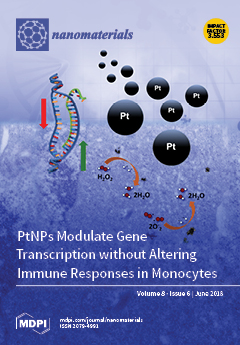In this study, we report the use of Al
2O
3 nanoparticles in combination with fluorine doped tin oxide (F:SnO
2, aka FTO) thin films to form hazy Al
2O
3-FTO nanocomposites. In comparison to previously reported FTO-based nanocomposites
[...] Read more.
In this study, we report the use of Al
2O
3 nanoparticles in combination with fluorine doped tin oxide (F:SnO
2, aka FTO) thin films to form hazy Al
2O
3-FTO nanocomposites. In comparison to previously reported FTO-based nanocomposites integrating ZnO and sulfur doped TiO
2 (S:TiO
2) nanoparticles (i.e., ZnO-FTO and S:TiO
2-FTO nanocomposites), the newly developed Al
2O
3-FTO nanocomposites show medium haze factor H
T of about 30%, while they exhibit the least loss in total transmittance T
tot. In addition, Al
2O
3-FTO nanocomposites present a low fraction of large-sized nanoparticle agglomerates with equivalent radius r
eq > 1 μm; effectively 90% of the nanoparticle agglomerates show r
eq < 750 nm. The smaller feature size in Al
2O
3-FTO nanocomposites, as compared to ZnO-FTO and S:TiO
2-FTO nanocomposites, makes them more suitable for applications that are sensitive to roughness and large-sized features. With the help of a simple optical model developed in this work, we have simulated the optical scattering by a single nanoparticle agglomerate characterized by bottom radius r
0, top radius r
1, and height h. It is found that r
0 is the main factor affecting the H
T(λ), which indicates that the haze factor of Al
2O
3-FTO and related FTO nanocomposites is mainly determined by the total surface coverage of all the nanoparticle agglomerates present.
Full article






